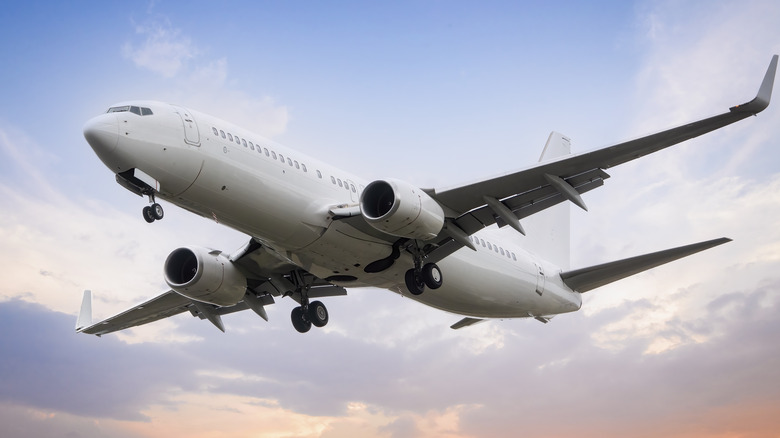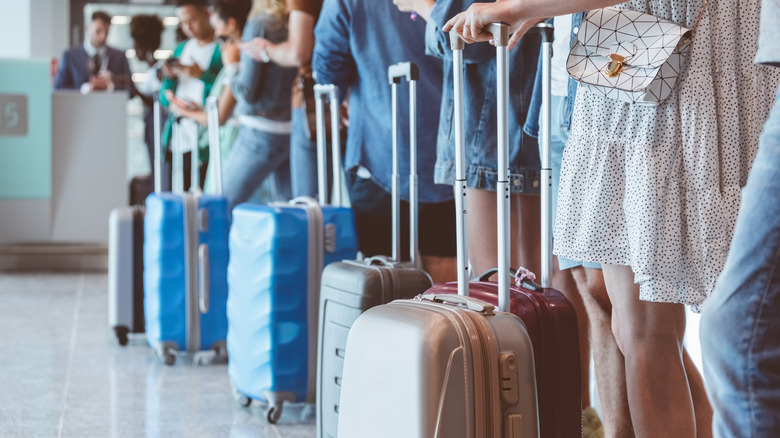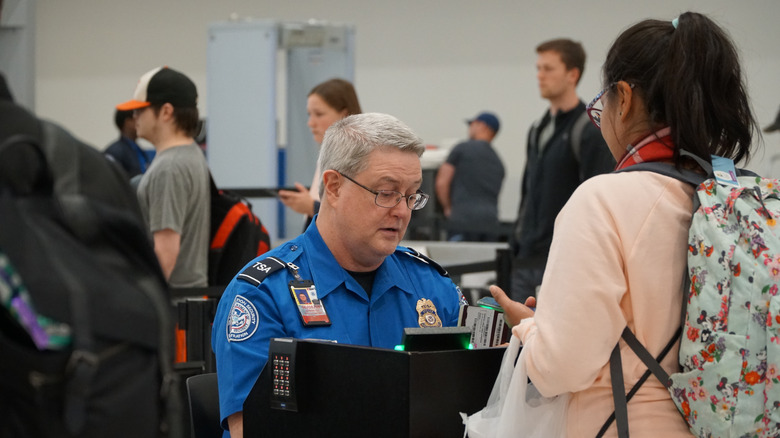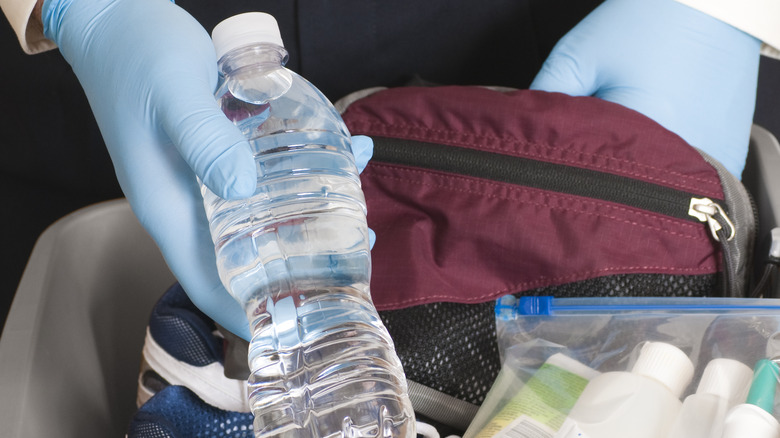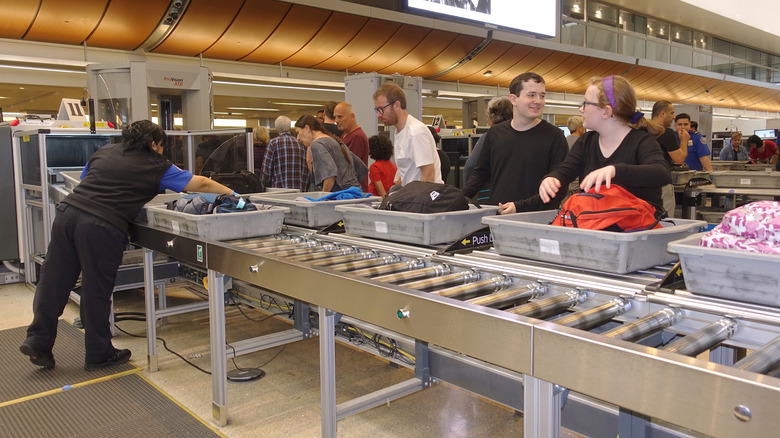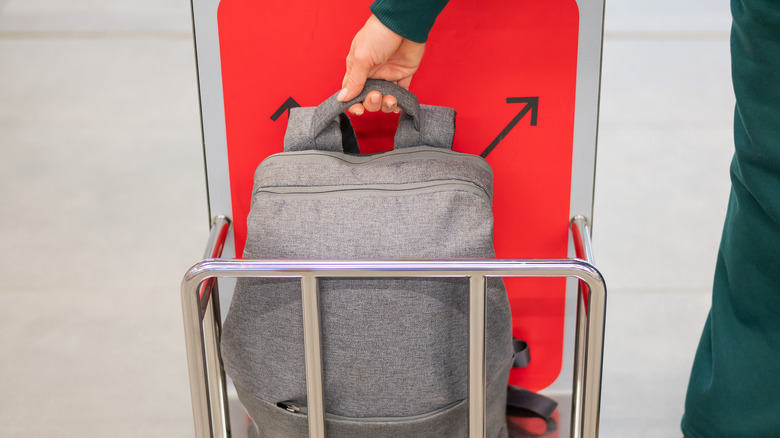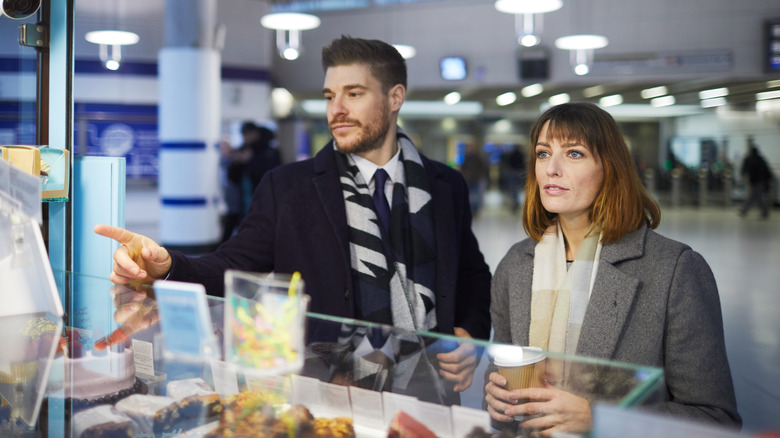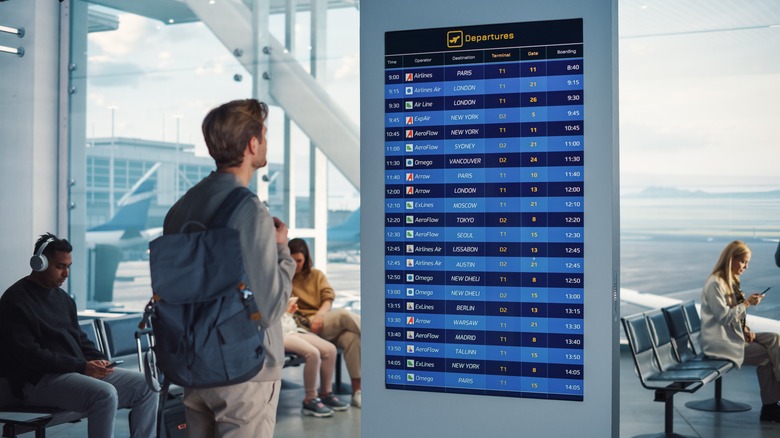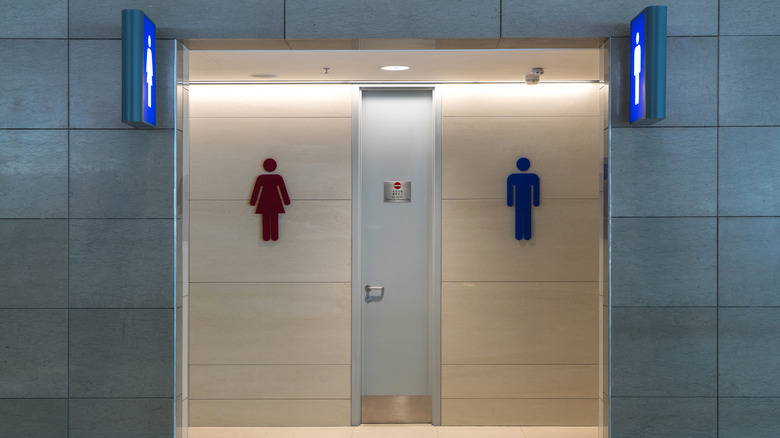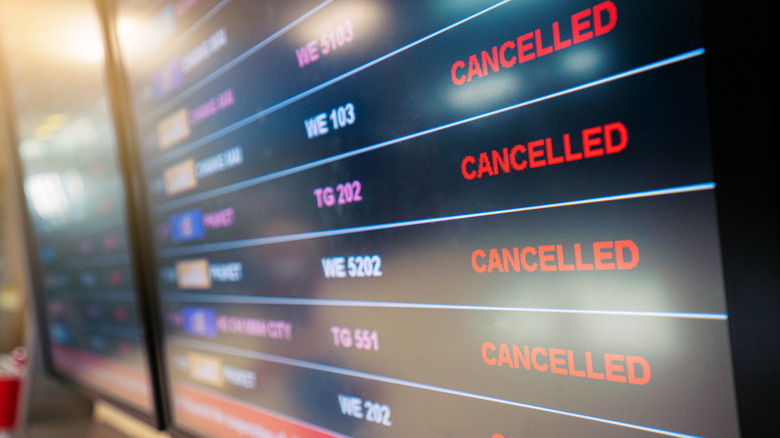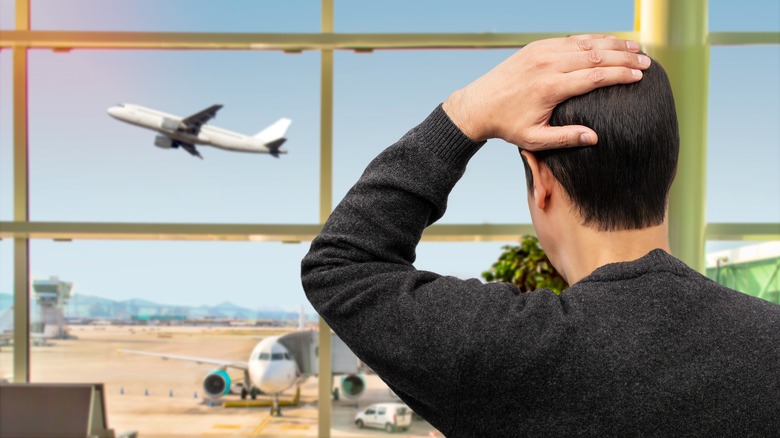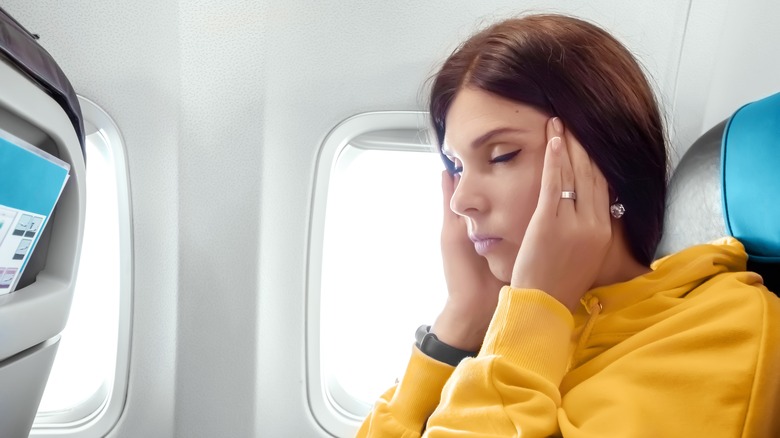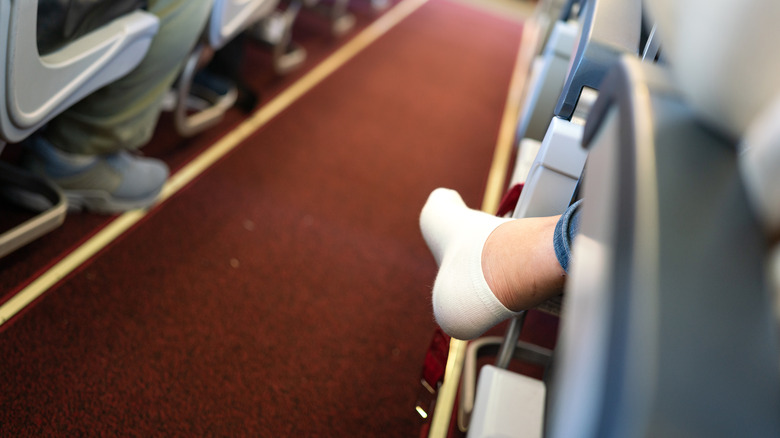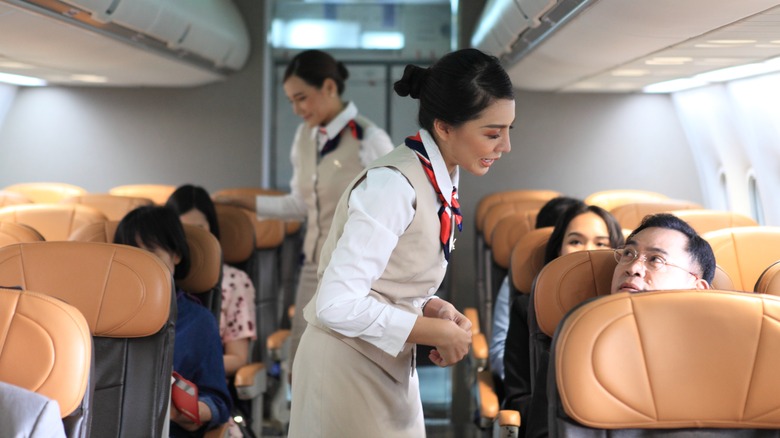Mistakes To Avoid If You're New To Traveling By Plane
We've all made mistakes when flying on an airplane. Despite your best-laid plans, something goes wrong, whether it's your fault or beyond your control. While you can't always change the outcome of an unpleasant travel situation, you can manage the hurdle better by being prepared for it — by being aware that the hurdle might trip you up in the first place, and therefore equipping yourself with the tools and/or mindset to avoid it.
Whether you seldom fly on an airplane or you're a frequent flyer, we're here to hype you up for your flight and help your journey go as smoothly as possible. By avoiding these mistakes, you'll be ready to pack your luggage correctly, navigate the airport stress-free, and enjoy yourself onboard the plane like a pro. From this point forward, that "fasten seatbelt" light is on because we're going skyward. If you can avoid the following common mistakes, you can help ensure a less turbulent flight experience.
Waiting until the last minute to book a flight
There's nothing like that crummy feeling of knowing you could have saved a significant amount of money if you had been a little more on top of your planning. If you have the foresight to know you'll be taking a trip a few months ahead of time, flight prices are likely to be cheaper the earlier you purchase. Sometimes trips are spontaneous by necessity (such as with a family emergency, etc.), but when you can, book your flight at least a few weeks in advance. Week-of and day-of ticket prices typically skyrocket.
While we're on the topic of mistakes to avoid when booking your flight, don't settle for the first price you see. Always consult multiple vendors before purchasing your tickets. Sometimes even the same seat on the same flight costs different amounts of money, depending on the website selling the ticket. It never hurts to shop around Expedia, Priceline, and the like — as well as airlines' official websites themselves — before finally booking your flight.
Checking in for your flight at the airport
If you're checking a bag, visiting your airline's support desk at the airport is an unavoidable task. If you only have a carry-on bag and/or a personal item, though, there's no need to stand in a long line to check in for your flight and pick up your tickets. You can do that before you leave home to save yourself some time.
To do so, download your airline's app and check in electronically the day before your flight. The app will ask a series of simple questions about your travel plans to make sure you've got everything ready to go, and ... that's it! Your ticket will appear within the app and will be accessible at any time, so you won't need to print anything or handle a paper ticket of any kind. One less step at the airport, score! In general, these apps are also handy for other purposes, such as checking your flight's status or managing your ticket.
Forgetting where you parked
As much as you tell yourself "C4," your parking row, is easy to remember, write it down when you arrive at the airport. Trust us, the last thing you want to do when arriving back at your hometown airport at the end of a trip is wander aimlessly in a sea of vehicles desperately hoping to locate your car. Jot your parking lot name and parking row number on a piece of paper, type it in your Notes app, or drop a pin at your car's location before leaving it behind. Do whatever it takes to make sure you can make it back to your car without any trouble, no matter how sharp you think your memory is.
While on the subject, also pay attention to the airport's internal transportation between the terminal and parking lots. We're guilty of getting on the wrong bus, arriving at an incorrect parking lot, and having to ride back to the terminal to find the right shuttle. It's a mistake nearly as frustrating — and easy to make — as forgetting where you parked.
Not having valid identification
Even if you think you have it on your person, double-check that your I.D. is with you before heading out the door for the airport. While bringing your I.D. for security purposes is one of the basic and most obvious requirements for flying, additional nuances about your I.D. might be easy to overlook. For example, ensure that your I.D. isn't expired. If possible, check on this several weeks prior to your flight to give yourself enough time to renew the I.D. (either online or by visiting your local DMV).
Whether you're using a driver's license or a passport as your form of identification at the airport, make sure TSA accepts it as a valid means of I.D. Come 2025, travelers in the U.S. will need a new type of identification called a Real I.D. to fly domestically. You can now register for a Real I.D. with any renewal of your driver's license. (Depending on the state, though, you may need to visit a DMV in person. Some states do not allow online Real I.D. registrations.) Though the pandemic and other various situations have delayed the roll-out of TSA's Real I.D. requirements, all flight passengers will need a Real I.D. by May 7, 2025.
Bringing liquids, creams, and unapproved items
Any sort of liquid — including drinks, lotion, shaving cream, you name it — must be no more than 3.4 ounces per container when traveling on an airplane. Before your trip, visit the grocery store to pick up travel-sized toiletries like toothpaste, hairspray, deodorant, and the like. Alternatively, you could forgo the travel-sized items and plan on making a pit stop once you arrive at your destination to retrieve full-size versions. (Just keep in mind you'll need to dispose of or give away anything left over before flying back.)
Since TSA prohibits travelers from bringing any liquids over 3.4 ounces, you'll be asked to throw away any full or even partially filled water bottles prior to going through security. A hack to avoid spending $7 on a Dasani in the terminal? Bring a refillable water bottle to fill up on the other side after you've gone through security. Just make sure it's completely empty when you arrive.
Not packing your luggage strategically
Certain items — like laptops, electronics, and anything containing liquids — might need to be removed from your luggage at the security checkpoint, depending on the type of detectors in use. Be prepared to follow TSA's instructions, as listed on its website. These include packing all liquid (and liquid-adjacent) items in a clear bag no larger than a quart and removing that bag from your luggage at security. TSA also officially requires travelers to remove from their luggage any electronics the size of a laptop or larger when passing through security.
Travel tip time! If you know for certain you'll need to remove specific items from your luggage at TSA, pack those items smartly within your bag for easy access. It's no fun unpacking all of the contents of your bags just to retrieve the camera at the bottom of your carry-on. Instead, pack that item on top. You can always re-pack everything in your preferred way after you go through security.
Measuring the size of your carry-on and personal item incorrectly
Airlines are strict about the size of your luggage. Which types of bags qualify as personal items, carry-ons, or checked baggage can get confusing. Making matters worse, not all airlines adhere to the same measurements. For example, just because American Airlines deemed your backpack small enough to be considered a personal item doesn't mean Frontier will. The latter might consider the backpack's size as a carry-on item, in which case you may need to pay a fee.
Make sure you're in the clear before traveling. Visit your airline's website to learn about its luggage specifications. If you know you'll need to purchase passage for a carry-on or a checked bag, go ahead and arrange that prior to traveling. The cost will be more expensive at the airport. If you're unsure about your bag once you arrive at the airport, visit your flight gate and ask an employee for help. They'll often have a mock storage compartment in which you can verify if your bag fits the airline's various-sized categories. If you need to check on this, do so as soon as you arrive at the terminal to avoid slowing things down for everyone during the boarding process.
Wasting money on expensive airport food
That measly, skimpy sandwich is how much money?! The in-flight Coca-Cola isn't free this time?! Sometimes eating at the airport — or on a plane, for that matter — is unavoidable. On long travel days, you'll simply need to factor the cost of airport food into your travel budget. Some travelers might be okay with this, and simply consider the time spent at the airport as part of the trip in and of itself, budgeting appropriately. Others may prefer to be more mindful of excess costs and allocate that money for other line items on the trip.
On shorter journeys, simply thinking through your travel day can help avoid spending a fortune on airport food. Consider adjusting your usual meal times if you'll be traveling during a time of day when you generally eat. Either eat before you leave home or have a dining location in mind for after you land. If you have room in your carry-on, you're also welcome to bring your own snacks with you.
Hovering near your gate
We're all going to the same place, on the same vehicle, and for the most part, we all already know where we'll be sitting on the plane. There's no need to hover near the gate to your plane before your boarding group is called. If you arrive at the airport super early, find a less congested area to relax instead. High-ceiling terminals are a stress-relieving dream if you can find one. The height helps the space feel less cramped, even if the same amount of people are under a low-ceiling terminal.
If there are complications or delays with your flight, that's another story. You might want to be near the gate to hear about any updates or alerts. If everything is going smoothly, though, and you haven't received any change-of-plans notifications on your phone through the airline's app, there's no need to crowd around the gate until shortly before boarding.
Not thinking ahead for bathroom breaks
Sometimes nature calls, and that's perfectly, well, natural. As much as you can manage it, though, be mindful of your liquid intake before your flight and avoid eating foods that typically don't sit well with your stomach. While you should drink plenty of water while flying, as traveling through the stratosphere is dehydrating, you'll need to manage your bathroom breaks.
Admittedly, this is easier said than done. Of all the pointers on our list, this one is probably one of the most difficult to control. That being said, you can still be smart about what you eat or drink in the hours leading up to your flight (as tempting as that milkshake is from the terminal's Panera). There's nothing wrong with needing a bathroom break on the plane and using the onboard restroom, but obviously, no one wants to spend the whole flight in there if they can help it. It's also a good idea to make one last trip to the bathroom just before you board the plane, even if you don't think you need to go ... just in case.
Not anticipating flight delays or cancellations
No one wants to have their flight delayed or canceled, but those changes are often beyond your control. If possible, plan some buffer time in anticipation of travel complications. This is an especially good practice when your reason for traveling is time-sensitive. For example, if you're flying en route to a wedding, the ceremony will go on with or without you (unless, y'know, you're the bride or groom). If your flight is scheduled for just a few hours before the wedding, and the flight is delayed, you might miss the entire reason for your trip. Whereas, if you're just taking a casual vacay to the beach, sure, it's a bummer if your flight gets delayed, but the trip itself isn't inherently reliant on a ticking clock.
In cases when time is of the essence, do yourself a favor and allot more time for traveling than you think you'll need. Travel at least one day before the most important item on your travel itinerary (like a wedding, concert, etc.). Even if you end up not needing the buffer, you'll have peace of mind knowing you have time to spare.
Missing your flight
Getting the whole family out the door to even go to school in the mornings can be a challenge, so making it to the airport on time can seem like nothing short of an Olympic sport. If arriving places on time isn't exactly your strong suit, work backward. Think of your flight's take-off time and consider every step of the arrival process and how long it could take, all the way from leaving your home to boarding the plane.
If you're scheduling a connecting flight, allow enough time to disembark your first plane and locate the gate for your next flight. Your seating on the first plane can significantly affect how long that process will take. For example, if you sit in the second-to-last row on a flight, you may wait 40 minutes between the time the plane touches down on the tarmac to the time you walk off the plane. If you have a short layover, you'll need to plan accordingly.
Not anticipating flight nausea
Real talk: As our bodies get older, we can't handle some experiences with the ease we formerly could. The books we always counted on reading while traveling from place to place? Even reading a paragraph or two while in motion now makes us dizzy. That scary roller coaster we loved riding at least three times when we visited our favorite amusement park? We can barely handle one trip around the track these days. Going an entire flight without getting nauseous? Uh, well ...
Even if you don't think you'll get sick from flying, consider packing some anti-nausea over-the-counter medication. Your body might not have as high a tolerance as it used to for instantaneously being thousands of feet in the sky. Feeling faint and/or needing to vomit on a plane is obviously one of the last things you hope will happen during your flight. That being said, it's better to have that Dramamine in your backpack. It's better to have it and not need it versus needing it and not having it.
Not bringing entertainment on the plane
While many planes now provide personal screens for passengers to select and watch movies, some planes still don't offer such luxuries. Even if you've prepared everything else thus far, arriving at your seat for a six-hour flight only to realize you forgot to plan for any onboard entertainment is ... not ideal. Unless you're paying for onboard Wi-Fi, you should consider downloading podcasts or movies to your phone or computer prior to flying. This will allow you to access them in airplane mode without an internet connection. (And yes, putting your phone into airplane mode really is important.)
Whether it's podcasts, movies, television shows, or music, think about what you'd like to keep you occupied while flying and plan accordingly. Locating your preferred entertainment and downloading it directly to your device is a relatively easy and quick process, but it's easy to forget to do.
Being inconsiderate of other passengers
We've all been there. You're settled in for a pleasant flight, and the passenger next to you disregards any and all notions of courtesy to their fellow travelers. Maybe their headphones are turned up to maximum volume, and you can hear their music just as easily as they can. Perhaps they're chatting with a buddy seated nearby, but speaking way louder than necessary. Or, maybe there's a passenger kicking the back of your seat.
Don't be the obnoxious travel companion, especially when sitting next to strangers. Certainly, you have a right to be comfortable and spend the flight according to your preferences, whether that pertains to noise, light, or other elements. However, be mindful of your fellow passengers' flight experience, too — and for the sake of everyone's gag reflex, leave those egg salad sandwiches at home, Oscar. A little mindfulness for your fellow passengers creates friendlier skies.
Wasting unused miles or points
Travelers had $10 billion worth of unused airline credit sitting in limbo at the end of 2020, according to Good Morning America. Especially following the canceled trips inflicted by the pandemic, you might have a "free" flight just waiting for you. Or, at least, a flight you've already paid for a while ago. In other cases, an airline may have given you flight credit as an apology for a previous flight delay or complication. When your flight is delayed long enough, airlines are typically required to provide you with flight credit or some other form of compensation. Also, if you use a credit card that accumulates air miles with purchases, you might have a hefty amount stocked up without realizing it.
All this to say, before you reach for your wallet, you may want to double-check to see if you have any credits accrued. Furthermore, keep tabs on the expiration date. You'd hate to let flight credits or airline miles go to waste just because you didn't use them in the allotted time window — especially if it's for a flight that you previously paid for. Make the most of your points!
Being impolite to flight attendants
You'd be surprised how thankless some passengers can be to the people whose literal job it is to serve them. It might seem like common sense to be polite to flight attendants, but some folks could use a refresher in Manners 101. We know we may be preaching to the choir here. Anyone frequenting an advice column concerning airplane etiquette and avoiding flying mistakes is likely going to be a polite passenger, and for that, we applaud you. Your kindness makes up for the lack of it displayed by others, even though it shouldn't have to.
We recently spoke with a flight attendant who shared some of the common mistakes travelers make while boarding a plane. Some passengers are just plain rude, like those who hand their trash to flight attendants when boarding, while other passengers might not realize the delays they cause by unpacking their luggage in the aisle. Although you may not be guilty of these mistakes, there's nothing wrong with a refresher to ensure everyone's flights go as smoothly as possible, including the flight attendants.
